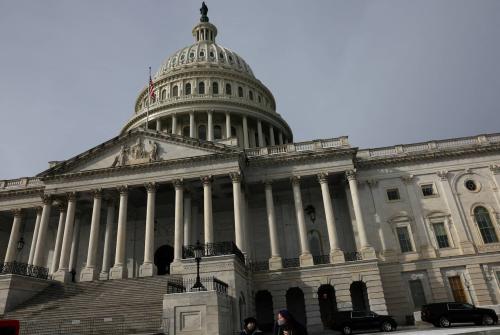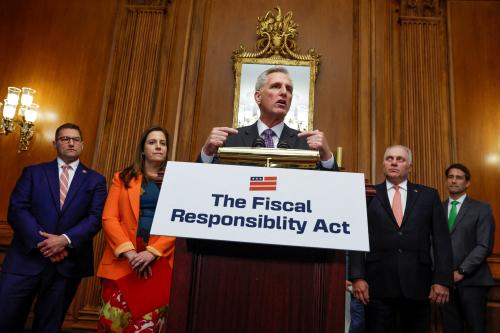In this age of political polarization, agreement across party lines on any subject is almost miraculous. And yet one thing everyone agrees on is this: America’s tax code is a mess.
When we focused on tax reform during the work of the Bipartisan Policy Center’s Debt Reduction Task Force, we kept hearing the same themes, which have been repeated by Senate Finance Committee Chairmen Max Baucus (D-Mont.) and House Ways and Means Committee Dave Camp (R-Mich.) before and since: the code is too complex, too hard to enforce, it costs growth and jobs and it contains countless special interest loopholes and favorable treatment for some taxpayers at the expense of others.
The “gee whiz” aspects of the tax code emerge daily: U.S. taxpayers and businesses spend 6.1 billion hours per year complying with the code. The instruction booklet for the basic Form 1040 now runs at 189 pages, whereas in the 1940s it took only two. The entire tax code stands at 5,296 pages. As the Internal Revenue Service notes, if tax compliance were considered an industry, it would take approximately 3,000,000 workers annually. And estimates show that individuals and companies shell out about $160 billion each year — equal to 11 percent of all income tax receipts — to comply with the tax code.
After the historic 1986 tax reform law, only 14 provisions were temporary. But now, as Congress confronts the “fiscal cliff” expected at the end of the year, it must address 132 expiring provisions in the code. Even under normal conditions, uncertainty about 132 expiring provisions would slow economic growth in many areas of the economy. But all agree that the fiscal cliff presents Congress with an even worse challenge — because individuals and companies have virtually no idea what taxes will exist in 2013.
In recent years special interests have proved powerful enough to block tax reform that would benefit the economy and most taxpayers. But this year could be different. The urgency of avoiding the fiscal cliff and crafting a grand bargain that stabilizes our growing debt creates the best opportunity for comprehensive tax reform since 1986 — maybe better.
Our task force, the Simpson-Bowles commission and other bipartisan groups have all concluded that a comprehensive fiscal plan stands on three pillars: economic growth, fundamental reform of entitlement spending and comprehensive tax reform that yields net new revenues. To help economic growth, spur private-sector expansion and create jobs, restore fairness and raise more revenues, we must fundamentally reform our tax structure.
Our task force made one big decision on taxes — no bit-by-bit approach would ever work. We think the best hope for comprehensive reform is to blow up the code and start over. Members of Congress will get as much grief from changing the 132 expiring provisions as they will from fundamentally reforming the code. If you are taking on the code, take it all on at once.
There were four touchstones as we developed our reform: pro-growth simplification; additional revenues to help pay down our debt; increased progressivity; and allowing most individuals to avoid filing an annual return.
Our task force has a “tax plan with sizzle.” It would reduce individual tax brackets to two, at 15 percent and 28 percent; reduce the top corporate rate to 28 percent; tax capital gains and dividends as ordinary income, excluding the first $1,000 of realized net capital gains or losses; establish a flat refundable child credit of $1,600 and replace the complicated Earned Income Tax Credit with a refundable earnings tax credit at a higher level, structured similarly to the recent Making Work Pay tax credit; provide a flat 15 percent refundable tax credit for charitable contributions and, for up to $25,000 a year, for mortgage interest on a principal residence; and make other simplifications to the rest of the code. It would also put tax employer-paid benefits at the same rates as cash wages, which should discourage over-generous health insurance as well as make the tax system more progressive.
Republicans should be attracted to the pro-growth aspects of our plan. It lowers marginal rates significantly and gets rid of provisions that attract capital into less-profitable uses for tax reasons. Of course, they won’t like taxing capital gains and dividends as ordinary income, but that is the price of lower rates. Democrats will like the greater progressivity that comes from the treatment of capital income and changing the mortgage interest to a credit. A mortgage interest credit at the 15-percent rate is far more favorable to middle-income homeowners, but less to homeowners with high incomes, who get disproportionate benefits now but don’t need a big incentive to buy houses.
Our plan is ambitious and workable. It should be enacted. Can it be? The president and Congress will give us that answer.



Commentary
Op-edOur Tax Reform Plan Deserves Another Look
July 25, 2012